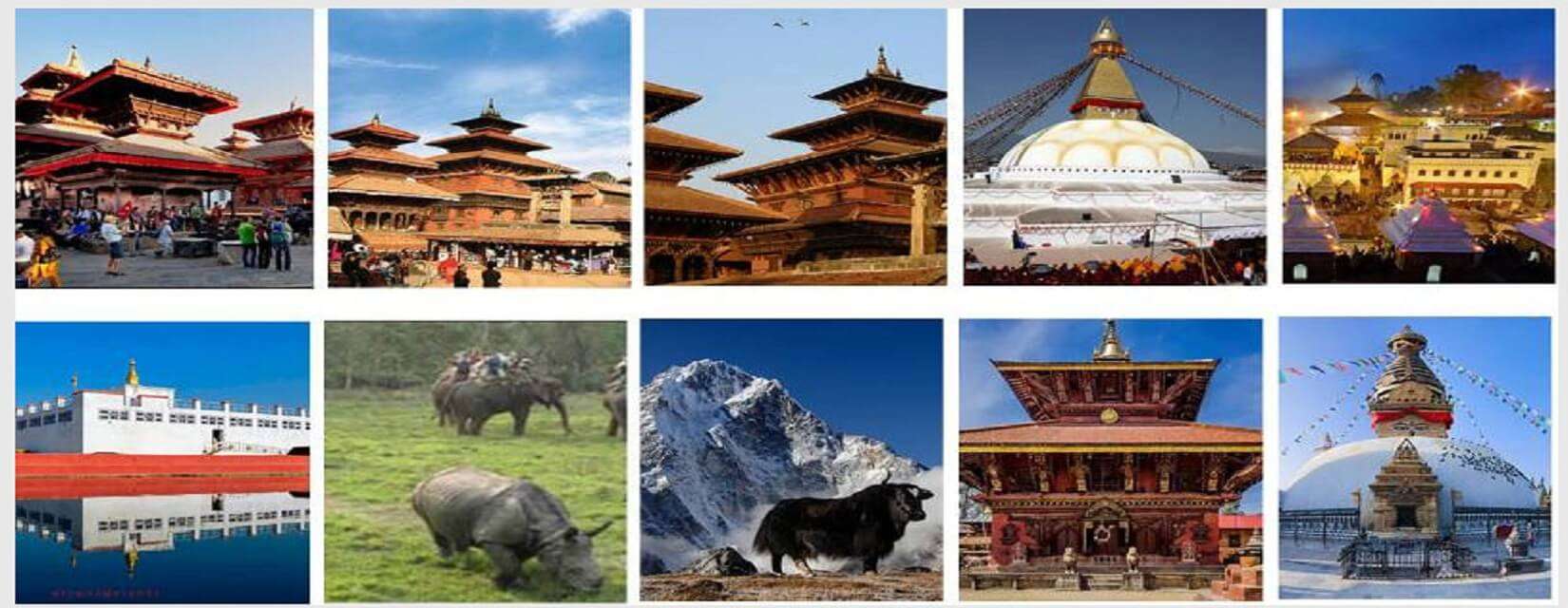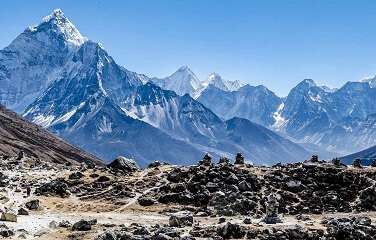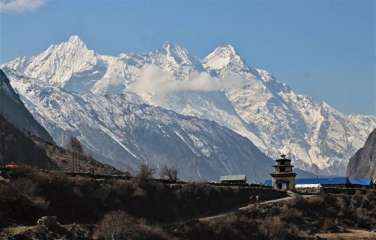Kathmandu Durbar Square:

Kathmandu Durbar Square, located in the heart of Nepal's capital, Kathmandu, is a historic and cultural hub showcasing the rich architectural heritage of the country. The square was the royal palace complex for the Malla kings and later the Shah dynasty and is surrounded by a remarkable collection of ancient palaces, courtyards, and temples built in the traditional Newar style.
Key highlights of Kathmandu Durbar Square include:
- Hanuman Dhoka Palace: The historic royal palace, which includes a museum and a series of courtyards.
- Taleju Temple: A towering temple dedicated to the goddess Taleju, accessible only to Hindus.
- Kumari Ghar: The residence of the living goddess Kumari, where visitors can sometimes glimpse the goddess from the courtyard.
- Kasthamandap: An ancient pavilion built from a single tree, which is said to be the origin of the name Kathmandu.
The square is a UNESCO World Heritage Site and an essential visit for anyone interested in Nepalese history and culture, reflecting centuries of artistry and craftsmanship. It is a vibrant area often filled with locals, tourists, vendors, and religious devotees, offering a vivid snapshot of life in Kathmandu.
Swayambhunath Stupa:

Often referred to as the Monkey Temple due to the presence of monkeys, Swayambhunath is one of the oldest and most revered Buddhist sites in Nepal. Perched atop a hill in the Kathmandu Valley, it offers a stunning panoramic view of the city. The stupa's iconic white dome and golden spire are adorned with the all-seeing eyes of Buddha.
Key highlights of Swayambhunath Stupa include:
- The Stupa: Featuring a white dome and a gilded spire adorned with the all-seeing eyes of Buddha.
- Prayer Wheels: Numerous prayer wheels inscribed with the mantra "Om Mani Padme Hum" surround the stupa.
- Harati Temple: A temple dedicated to the goddess Harati, protector of children, located in the complex.
- Statues and Shrines: Various statues and smaller shrines, including a large Buddha statue at the entrance.
- Monkeys: Sacred monkeys inhabit the temple, adding to its lively atmosphere.
- Panoramic Views: Offers stunning views of Kathmandu Valley from its hilltop location.
- Prayer Flags: Colorful prayer flags inscribed with prayers flutter around the stupa.
- Vajra: A large gilded vajra (thunderbolt scepter) symbolizing indestructibility and spiritual power stands in front of the stupa.
- These elements make Swayambhunath a vital cultural and spiritual landmark in Kathmandu.
Pashupatinath Temple:

Located on the banks of the Bagmati River, Pashupatinath is one of the holiest Hindu temples dedicated to Lord Shiva. It is a sprawling collection of temples, ashrams, and inscriptions. Non-Hindus can view the main temple from across the river, which is a significant pilgrimage site attracting thousands of devotees, especially during the Maha Shivaratri festival.
Key highlights of Pashupatinath Temple include:
- Main Temple: The main temple features a pagoda-style structure with a gilded roof and intricately carved silver doors, accessible only to Hindus.
- Lingam of Shiva: The central shrine houses a revered lingam (symbolic representation) of Lord Shiva.
- Bagmati River: The temple is situated on the sacred Bagmati River, where Hindu cremation ceremonies are commonly conducted along its ghats (steps).
- Arya Ghat: This important cremation site is located within the temple complex and is a significant place for final rites in the Hindu tradition.
- Bhasmeshvar Ghat: Another key cremation area where rituals are performed.
- Deer Park: Adjacent to the temple complex is a forest area with deer, symbolizing Shiva's connection with wildlife.
- Numerous Temples and Shrines: The extensive complex includes many smaller temples and shrines dedicated to various deities, such as the Vasuki Nath Temple, Unmatta Bhairav Temple, and Surya Narayan Temple.
- Festivals: Pashupatinath is especially vibrant during festivals like Maha Shivaratri, attracting thousands of pilgrims and sadhus (holy men) from all over Nepal and India.
- Living Quarters for Sadhus: The temple provides accommodations for sadhus who come to worship and reside there.
- Cultural Significance: The temple is a UNESCO World Heritage Site, reflecting its historical, religious, and cultural importance in Nepalese society.
These highlights make Pashupatinath Temple a crucial spiritual, cultural, and historical landmark in Nepal.
Boudhanath Stupa:

One of the largest spherical stupas in Nepal, Boudhanath is a major pilgrimage site for Buddhists. It is situated in Kathmandu and is surrounded by numerous monasteries. The stupa is especially vibrant during the Tibetan New Year when it becomes a center for Buddhist rituals and activities.
Key highlights of Boudhanath Stupa include:
- Massive Mandala: The stupa features a vast mandala, making it one of the largest spherical stupas in the world.
- Central Dome and Spire: The white dome is crowned with a golden spire painted with the all-seeing eyes of Buddha, symbolizing awareness.
- Prayer Wheels: Surrounding the stupa are prayer wheels that pilgrims spin while walking clockwise around the monument.
- Tibetan Buddhist Monasteries: Numerous monasteries encircle the stupa, reflecting the area's strong Tibetan Buddhist influence.
- Prayer Flags: Colorful prayer flags strung around the stupa carry prayers and mantras, fluttering in the wind.
- Buddhist Pilgrimage Site: A major pilgrimage destination, particularly vibrant during Tibetan New Year (Losar) and other Buddhist festivals.
- Shops and Cafés: The area around the stupa is filled with shops selling religious items, handicrafts, and cafés with rooftop views of the stupa.
These elements make Boudhanath Stupa a vital religious, cultural, and social hub in Kathmandu.
Changu Narayan Temple:

This ancient Hindu temple is located in Bhaktapur and is dedicated to Lord Vishnu. It is considered the oldest temple in the Kathmandu Valley, dating back to the 5th century. The temple’s architecture is an exquisite example of Nepalese craftsmanship, adorned with intricate wood and stone carvings.
Key highlights of Changu Narayan Temple include:
- Ancient Temple: Dating back to the 5th century, it is considered the oldest temple in the Kathmandu Valley.
- Vishnu Deity: The temple is dedicated to Lord Vishnu and features an impressive stone idol of Vishnu as Narayan.
- Newari Architecture: Showcases exquisite Newari architecture with intricate wood and stone carvings.
- Historic Inscriptions: Home to ancient inscriptions, including the oldest known inscription in the Kathmandu Valley, dating back to the Licchavi period.
- Garuda Statue: A prominent statue of Garuda, the mythical bird and vehicle of Vishnu, stands in front of the temple.
- Decorative Sculptures: Includes elaborate sculptures of various deities and mythical creatures.
- Cultural Significance: Recognized as a UNESCO World Heritage Site, highlighting its historical and cultural importance.
These features make Changu Narayan Temple a significant religious and historical site in Nepal.
Patan Durbar Square:

A marvel of Newar architecture, Patan Durbar Square is in the heart of Patan city. It houses the ancient royal palace where the Malla kings of Lalitpur resided. The square is filled with temples, statues, and courtyards, reflecting the city's artistic heritage. The Krishna Mandir, with its 21 golden pinnacles, is a notable monument here.
Key highlights of Patan Durbar Square include:
- Royal Palace: The ancient royal palace complex, with three main courtyards (Mul Chowk, Sundari Chowk, and Keshav Narayan Chowk), is a centerpiece of the square.
- Krishna Mandir: A prominent temple built entirely of stone, dedicated to Lord Krishna, featuring intricate carvings and 21 golden pinnacles.
- Golden Temple (Hiranya Varna Mahavihar): A revered Buddhist monastery with beautiful gilded facades and statues.
- Mahabouddha Temple: Known as the "Temple of a Thousand Buddhas," it is adorned with thousands of terracotta tiles, each bearing an image of Buddha.
- Vishwanath Temple: Dedicated to Lord Shiva, featuring two stone elephants guarding the entrance and exquisite carvings.
- Sundari Chowk: Notable for its sunken water tank (Tusha Hiti) and elaborately carved stone sculptures.
- Patan Museum: Housed within the palace, the museum exhibits a rich collection of traditional Nepalese art and artifacts.
These highlights make Patan Durbar Square a vital historical and cultural landmark in Nepal.
Bhaktapur Durbar Square:
This square is a living museum of medieval arts and architecture. Bhaktapur Durbar Square is known for its 55-Window Palace, Vatsala Temple, and the impressive Nyatapola Temple, which stands tall with its five tiers. The city of Bhaktapur itself is a UNESCO site, offering a glimpse into the traditional Newari lifestyle.
Lumbini:

The birthplace of Lord Buddha, Lumbini is a UNESCO World Heritage Site located in the Rupandehi District of Nepal. The site includes the sacred Bodhi tree, an ancient bathing pond, the Ashokan pillar, and the Maya Devi Temple, which marks the exact spot where Buddha was born. It is a pilgrimage site for Buddhists around the world.
Key highlights of Lumbini include:
- Maya Devi Temple: Marks the exact spot where Buddha was born, featuring ancient ruins and a sacred pond.
- Ashokan Pillar: Erected by Emperor Ashoka in 249 BCE, it bears inscriptions commemorating his visit.
- Sacred Bodhi Tree: A descendant of the original Bodhi tree under which Buddha attained enlightenment, located near the Maya Devi Temple.
- Monastic Zone: Divided into East (Theravada) and West (Mahayana and Vajrayana) zones, containing numerous monasteries built by Buddhist communities from around the world.
- Lumbini Museum: Showcases artifacts and relics related to Buddha's life and the history of Lumbini.
- World Peace Pagoda: A stunning white stupa built by Japanese Buddhists, symbolizing peace and harmony.
- Lumbini Crane Sanctuary: A serene natural habitat within the Lumbini Development Area, home to Sarus cranes and other wildlife.
These highlights make Lumbini a revered and historically rich destination for pilgrims and visitors worldwide.
Chitwan National Park:

This park was the first national park in Nepal and is a UNESCO World Heritage Site recognized for its rich biodiversity. Located in the subtropical Inner Terai lowlands, it is home to endangered species like the one-horned rhinoceros and Bengal tiger. The park offers jungle safaris, bird watching, and river adventures.
Key highlights of the Chitwan National Park include:
- Wildlife: Home to endangered species such as the one-horned rhinoceros, Bengal tiger, Asian elephant, and gharial crocodile.
- Bird Watching: A paradise for bird enthusiasts with over 500 species of birds, including the endangered Bengal florican and various migratory birds.
- Jungle Safaris: Offers thrilling jeep safaris and guided walks through dense forests to spot wildlife in their natural habitat.
- Tharu Cultural Experience: Opportunities to visit nearby Tharu villages and experience their unique culture, traditions, and hospitality.
- Elephant Breeding Center: Located within the park, it focuses on the conservation and breeding of elephants.
- River Adventures: Exciting canoe rides along the Rapti River to observe crocodiles, birds, and aquatic life.
These highlights make Chitwan National Park a must-visit destination for nature lovers and wildlife enthusiasts seeking an authentic jungle experience in Nepal.
Sagarmatha National Park:

Dominated by Mount Everest (EBC TREK), the highest peak in the world, Sagarmatha National Park is a UNESCO World Heritage Site renowned for its dramatic landscapes and unique Sherpa culture. The park encompasses glaciers, deep valleys, and mountainous terrain. It is a haven for trekkers and mountaineers, offering spectacular views and a chance to experience the diverse flora and fauna of the Himalayan region.
Key highlights of Sagarmatha National Park short include:
- Mount Everest: The world's highest peak, standing at 8,848 meters (29,029 feet), is a major draw for trekkers and mountaineers.
- Khumbu Region: Home to Sherpa villages and cultural sites like Tengboche Monastery, offering insights into Sherpa culture and traditions.
- Himalayan Flora and Fauna: Diverse ecosystems ranging from pine and birch forests to alpine meadows, home to rare species like the snow leopard, red panda, and Himalayan tahr.
- Sagarmatha (Everest) Base Camp Trek: A popular trekking route that takes adventurers to the base camp of Mount Everest, offering stunning views of surrounding peaks.
- Gokyo Lakes: A series of turquoise glacial lakes nestled among snow-capped peaks, offering breathtaking scenery and a serene atmosphere.
- Cultural and Religious Sites: Including ancient monasteries, prayer wheels, and stupas that reflect the region's Buddhist heritage.
- World Heritage Site: Recognized by UNESCO for its natural and cultural significance, preserving the fragile Himalayan ecosystem and traditional Sherpa way of life.
These World Heritage Sites in Nepal not only attract tourists from all over the globe but also serve as a testament to the country's cultural and natural wealth. They are crucial for the preservation of Nepal's historical and environmental legacy.





